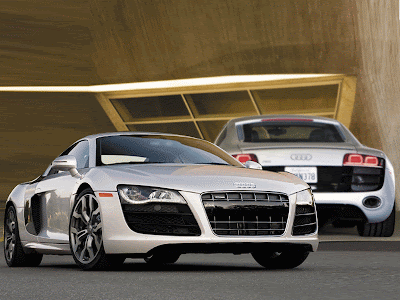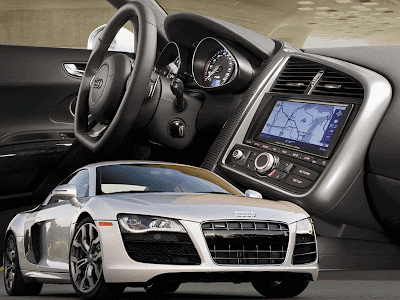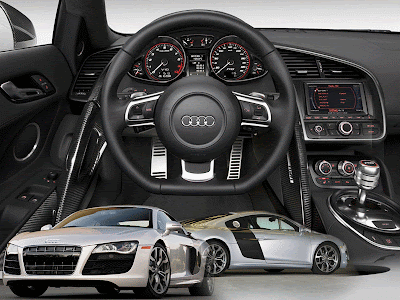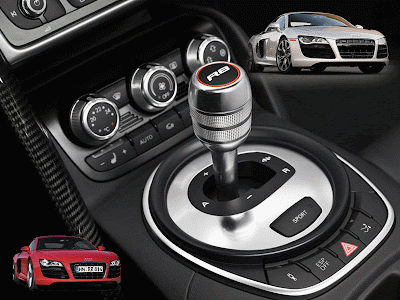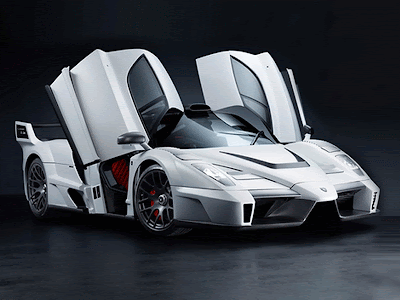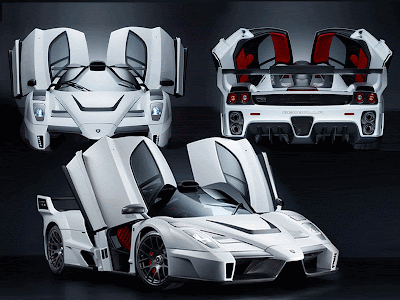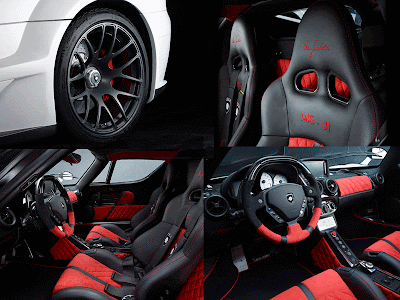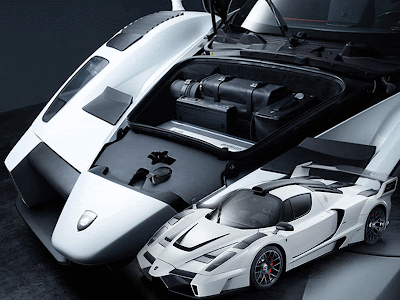|
|---|
Showing posts with label 2010. Show all posts
Showing posts with label 2010. Show all posts
Monday, May 3, 2010
2010 Audi R8 V10 5.2 FSI quattro high-performance Sports Car
0 komentar Diposkan oleh xcode in 11:03 AM2010 Audi R8 V10 5.2 FSI quattro
Audi announced that the price for the highly anticipated 2010 Audi R8 5.2 FSI quattro V10 sports car will be rolled out in Germany in the second quarter of 2009 at a basic price of EUR 142,400. The Audi R8 V10 is the result of cumulative know-how from Audi's string of Le Mans victories. Its naturally aspirated engine combines racing technology such as dry sump lubrication with FSI gasoline direct injection. The ten-cylinder design is the perfect synthesis for impressive top performance, mighty pulling power, and low weight. Starting in 2009, this engine will also prove its potential on the world's racetracks - in the new Audi R8 GT3 racing car Audi is developing for customer teams in conformance with the GT3 rules.
2010 Audi R8 V10 5.2 FSI quattro
Audi R8 V10 5.2 FSI quattro is the next variant of its top-of-the-line model. With the Audi R8, the brand has established itself at the forefront of high-end sports cars from the very start - and now comes the Audi R8 V10. Its 5.2-liter, ten-cylinder engine churns out 386 kW (525 hp) and 530 Nm (390.91 lb-ft) of torque, which makes for breathtaking performance. With superior Audi technologies such as quattro all-wheel drive, the lightweight aluminum body, the innovative all-LED headlights, and its striking design, the Audi R8 V10 takes pole position against the competition.
2010 Audi R8 V10 5.2 FSI quattro
The V10 engine in the production sports car will be almost identical in construction to the one in the racing version. Its displacement is 5,204 cc, at 6,500 rpm it delivers 530 Nm (390.91 lb-ft) of torque, at 8,000 rpm its power tops out at 386 kW (525 hp). The specific power output is 100.9 hp per liter of displacement - and each hp has to propel only 3.09 kilograms (6.91 lb) of weight, because the Audi R8 V10 in the version with the six-speed manual gearshift weighs only 1,620 kilograms (3571 lb). The engine accounts for 258 of these kilograms (569 lb) - that's only 31 kilos (68 lb) more than the V8.
2010 Audi R8 V10 5.2 FSI quattro
The 5.2-liter powerplant uses direct injection according to the FSI principle developed by Audi. The Audi R8 V10 with R tronic gets by on an average of 13.7 liters per 100 km (17.17 US mpg). The Audi R8 V10 5.2 FSI quattro rockets from zero to 100 km/h (62.14 mph) in 3.9 seconds. In the version with the sequentially shifting R tronic it reaches 200 km/h (124.27 mph) in another 8.1 seconds. Even then its propulsive power hardly lessens: it's sufficient to reach a top speed of 316 km/h (196.35 mph). The immense force, the spontaneity and the thrust of the acceleration, plus the sound of the engine - all these impressions coalesce into a breathtaking sports car experience. The V10 plays a concert with growling bass tones and powerful high notes, which grows into a grandiose fortissimo as the engine revs up. This sonorous acceleration doesn't reach its limit until 8,700 rpm.
2010 Audi R8 V10 5.2 FSI quattro
A contributing factor to the wide lead in traction and driving safety of the Audi R8 V10 over the competition is quattro all-wheel drive - it's the superior technology especially for a high-performance sports car. Four powered wheels get more grip than two. They enable the driver to step on the gas sooner when coming out of a curve. It's not only the traction that benefits, but also the transverse dynamics and the stability.
2010 Audi R8 V10 5.2 FSI quattro
Label: 2010, audi, Sports Car, V10
Friday, April 30, 2010
2010 Gemballa Super Sports Car MIG-U1 Ferrari Enzo
Now, the company manager from Leonberg near Stuttgart takes on a new challenge. The automobile manufacturer turns the most potent super sports car from Maranello, the Ferrari Enzo, into the GEMBALLA MIG-U1 - an individually produced edition, limited to only 25 cars. In the last 27 years, Uwe Gemballa has achieved the best world-wide reputation for refining Porsche cars. The core part of the overall makeover is the entirely re-engineered aerodynamics concept by GEMBALLA. Without any exception, the manufacturer produces all components in real carbon in order to combine lowest weight with highest material strength.
2010 Gemballa Super Sports Car MIG-U1 Ferrari Enzo
Owing to the active aerodynamics conception, the front spoiler lip generates an additional downthrust of up to 35 kilograms at the front axle, according to the individual position. Analogically, the flap on the newly designed rear spoiler generates even up to 85 kilograms more downthrust on the rear wheels. For optimal handling results, the flap lowers, as soon as the car reaches a speed of 120 km/h. In this way, the GEMBALLA-aerodynamics concept adjusts to the outer conditions and always ensures perfect road holding characteristics. All components of the aerodynamics kit attribute to this: starting from the new front skirt with spoiler lip, over the door extensions to the diffuser and rear spoiler.
2010 Gemballa Super Sports Car MIG-U1 Ferrari Enzo
The air duct system of the GEMBALLA MIG-U1 does not only help bringing the power of the twelve-cylinder car onto the road. At the same time, the engineers from Leonberg (Baden-Wurttemberg) develop an extensive ventilation- and cooling concept. Here, both the front and the back wheel-houses are supplied with cooling air and this guarantees an optimal use of the high performance braking system. The GEMBALLA car body components therefore guarantee the functionality of the new super sports car and provide the car with a unique look at the same time. Following the design of Formula-1 racing cars, the GEMBALLA MIG-U1 has an extended front and an edged rear spoiler. Formerly rounded edges were replaced in order to provide the car with an aggressive look with greedy air inlets and outlets.
2010 Gemballa Super Sports Car MIG-U1 Ferrari Enzo
The twelve cylinder engine of the GEMBALLA MIG-U1 works with an optimised motor management and an especially adjusted exhaust system. This combination allows a performance output of 700 hp (515 kW). The four-pipe system with pneumatic flap control is added to the sports catalyser. The end-pipes are equipped with the typical GEMBALLA heat shield and share the exit into the rear skirt with the exhaust ducts of the rear wheel houses.
2010 Gemballa Super Sports Car MIG-U1 Ferrari Enzo
In the interior, GEMBALLA devises a control centre which perfectly combines functionality and comfort. The especially for the GEMBALLA MIG-U1 designed seats, the custom-made centre console and the sports steering wheel with its leather-ultra suede combination guarantee full control over the car. At the same time,
the interior of this super sports car reflects pure luxury.
2010 Gemballa Super Sports Car MIG-U1 Ferrari Enzo
With the GEMBALLA MIG-U1, the automobile manufacturer once again proves that its know-how is not only limited to Porsche cars. On the basis of the already exhilarating Ferrari Enzo, the engineers developed a unique car. But even the limited edition with only 25 cars is not exclusive enough for GEMBALLA. Therefore, every single GEMBALLA MIG-U1 is individually adjusted. This ensures that there will not be any identical cars. Therefore, the specialist with its reputation for unique high-end refinement once again meets the requirements for highest individuality.
2010 Gemballa Super Sports Car MIG-U1 Ferrari Enzo
2010 Gemballa Super Sports Car MIG-U1 Ferrari Enzo
Label: 2010, Super Sport Car
Thursday, April 29, 2010
The hard top echoes the feel of this intense, high-tech assembly: It uses preformed profile technology derived from the world of sailing. It blends with the body, creating the illusion of a Coupé. The Peugeot SR1, however, radiates the same visual strength, with or without the hard top. Finally, the Peugeot SR1 Concept displays the new Peugeot Lion badge. Redesigned, finely worked and sculpted, it mirrors perfectly the perception of the vehicle as a whole.
2010 Peugeot Sports Coupe SR1 Concept
Overall the Peugeot SR1 concept car gives the impression it has been carved from a solid block of material, monolithic, protective, sculptural and dynamic. At every moment it makes a great play on contrasts: purity and technological sophistication, authenticity and advanced technologies, expressiveness and understatement. making it a car that is quite simply. desirable!
2010 Peugeot Sports Coupe SR1 Concept
The interior ambience blends colours and materials, with strong references to "a past motoring era" combined with "the latest advanced technology". Inside the vehicle, patinated leather and different grained wood are examples of the use of authentic and natural materials, warm, sensual and charged with history, that blend seamlessly with, "high tech" materials such as nickel and satin-finished chrome.
2010 Peugeot Sports Coupe SR1 Concept
The Peugeot SR1 Concept also blends styles in terms of its technical characteristics. For example, it incorporates HYbrid4 technology, which will be launched in the Peugeot 3008 in 2011. In the Peugeot SR1, at the front, a 1.6 litre THP petrol engine with a power of 160 kW (218 bhp), is combined with a rear electric motor developing 70 kW (95 bhp). In electric only mode, the car becomes a ZEV (Zero Emission Vehicle), while its combined cycle fuel consumption is only 4.9 litres/100 km or 119 g/km of CO2. When the two powertrains operate simultaneously, the SR1 develops a potential maximum power of 230 kW (313 bhp) and also benefits from 4-wheel drive.
2010 Peugeot Sports Coupe SR1 Concept
Using HYbrid4 technology, which will eventually become available on different models in the Peugeot range, the SR1 concept offers convincing proof that driving pleasure can be combined with environmental friendliness.
The vehicle’s dynamic efficiency is enhanced by the use of a rigid, lightweight structure comprising of a one-piece body and a tubular chassis onto which are mounted the mechanical components and suspension, which consists of double wishbones with drop links both at the front and the rear.
2010 Peugeot Sports Coupe SR1 Concept
For even greater driving precision, the Peugeot SR1 Concept benefits from the adoption of 4-wheel steering. The turning angle of the rear wheels is controlled as a function of the vehicle speed, via motorised links on the rear wishbones, giving the vehicle superb agility under all circumstances.
The Peugeot SR1 Concept car will be unveiled to the general public at the 2010 Geneva Motor Show.
Label: 2010, Hybrid Car, peugeot, Sport Car Coupe
Wednesday, April 28, 2010
The hard top echoes the feel of this intense, high-tech assembly: It uses preformed profile technology derived from the world of sailing. It blends with the body, creating the illusion of a Coupé. The Peugeot SR1, however, radiates the same visual strength, with or without the hard top. Finally, the Peugeot SR1 Concept displays the new Peugeot Lion badge. Redesigned, finely worked and sculpted, it mirrors perfectly the perception of the vehicle as a whole.
2010 Peugeot Sports Coupe SR1 Concept
Overall the Peugeot SR1 concept car gives the impression it has been carved from a solid block of material, monolithic, protective, sculptural and dynamic. At every moment it makes a great play on contrasts: purity and technological sophistication, authenticity and advanced technologies, expressiveness and understatement. making it a car that is quite simply. desirable!
2010 Peugeot Sports Coupe SR1 Concept
The interior ambience blends colours and materials, with strong references to "a past motoring era" combined with "the latest advanced technology". Inside the vehicle, patinated leather and different grained wood are examples of the use of authentic and natural materials, warm, sensual and charged with history, that blend seamlessly with, "high tech" materials such as nickel and satin-finished chrome.
2010 Peugeot Sports Coupe SR1 Concept
The Peugeot SR1 Concept also blends styles in terms of its technical characteristics. For example, it incorporates HYbrid4 technology, which will be launched in the Peugeot 3008 in 2011. In the Peugeot SR1, at the front, a 1.6 litre THP petrol engine with a power of 160 kW (218 bhp), is combined with a rear electric motor developing 70 kW (95 bhp). In electric only mode, the car becomes a ZEV (Zero Emission Vehicle), while its combined cycle fuel consumption is only 4.9 litres/100 km or 119 g/km of CO2. When the two powertrains operate simultaneously, the SR1 develops a potential maximum power of 230 kW (313 bhp) and also benefits from 4-wheel drive.
2010 Peugeot Sports Coupe SR1 Concept
Using HYbrid4 technology, which will eventually become available on different models in the Peugeot range, the SR1 concept offers convincing proof that driving pleasure can be combined with environmental friendliness.
The vehicle’s dynamic efficiency is enhanced by the use of a rigid, lightweight structure comprising of a one-piece body and a tubular chassis onto which are mounted the mechanical components and suspension, which consists of double wishbones with drop links both at the front and the rear.
2010 Peugeot Sports Coupe SR1 Concept
For even greater driving precision, the Peugeot SR1 Concept benefits from the adoption of 4-wheel steering. The turning angle of the rear wheels is controlled as a function of the vehicle speed, via motorised links on the rear wishbones, giving the vehicle superb agility under all circumstances.
The Peugeot SR1 Concept car will be unveiled to the general public at the 2010 Geneva Motor Show.
Label: 2010, Hybrid Car, peugeot, Sport Car Coupe
Subscribe to:
Posts (Atom)











